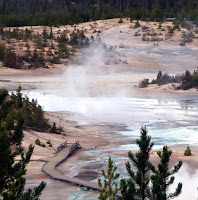This is a continuing series of posts on the world’s first National
Park – Yellowstone. There are so many natural wonders found within
its 2.2 million acres. Among its many popular destinations is the
Norris Geyser Basin.
Norris is the hottest geyser basin in the Park. Most of the thermal
features here have temperatures above the boiling point (around 200
degrees F). Scientists have drilled a hole 1,087 feet deep and
measured temperatures as high as 459 degrees!
As I mentioned in my previous post, the Norris Geyser Basin is
separated into two trails – the Back Basin and the Porcelain Basin.
In this post, we will be touring the Porcelain Basin. The
half-mile trail begins at the museum near the parking lot. The
museum opened in 1930 to help Park visitors understand Yellowstone’s
geologic history.
Historic Museum Building
The Museum is the connector between the Back Basin and Porcelain
Basin. Porcelain Basin was named in 1884 because of the milky white
geyserite that covered most of the basin.
NPS Map
After we go through the Museum, the trail splits. The right path is
a shorter loop trail leading to Congress Pool and Porcelain Springs.
The trail to the left is the longer loop trail where most of the
thermal features are located. We want to see the entire Porcelain
Basin. So, we will be walking both loop trails (certain stretches are shared by both trails). The left trail begins
with a hillside overlook of Porcelain Basin.
Porcelain Basin Overlook
Boardwalk Trail
As the trail descends down the hillside, it passes Black Growler Steam Vent and Ledge Geyser. Ledge Geyser is the second largest geyser in the Norris Geyser Basin. While eruptions are rare, it has been known to shoot water 125 feet into the air. Steam can be seen from its vents. It was named in 1927 for its position under a ledge of geyserite.
Black Growler Steam Vent (on left) & Ledge Geyser (on right)
Once again, the trail splits. The path to the right is part of the
smaller loop trail. We will do that later. We follow the left trail
(part of the longer loop trail). At this fork in the trail, we see
Sunday Geyser. On a Sunday in 1964, “Milky Geyser” was born.
Later, the name was changed to Sunday Geyser. It hasn’t been
active since the early 1980’s.
Sunday Geyser (2006)
Whirligig Geyser was named in 1904 because its water swirls in its
crater during eruptions. This is one of the most colorful areas in
the Porcelain Basin. The lime-green algae thrive in these warm acid
waters while the orange cyanobacteria (bacteria that obtains their
energy through photosynthesis) may be found in the runoff streams.
Whirlygig Geyser (2006)
During our 2011 visit, Pinwheel Geyser could be seen from an
observation platform at the north end of the boardwalk. However, in
2015, this platform was removed and a new boardwalk trail was built
farther away from Pinwheel Geyser.
Overlook View of Pinwheel Geyser Observation Deck (2011)
Colorful Run-Off Near Pinwheel Geyser
For a short distance, a dirt trail leads us along the edge of a
forest.
Trail Through Forest
Edge of Forest
We cross the East Fork of Tantalus Creek.
East Fork Tantalus Creek (2014)
In 1967, Crackling Lake (formerly known as Spring #39) was named
because of the popping sounds from nearby springs on its southern
shore.
Crackling Lake (2006)
At this point, the longer loop trail returns to the Porcelain Basin
Overlook.
Overlook - Crackling Lake
Now, it’s time to hike the shorter loop trail. At the beginning of
the trail (near the Museum), we head down the path on the right. It
takes us to Congress Pool. It was named in 1891 to recognize the
Fifth International Geological Congress in Yellowstone.
Congress Pool (2006)
We continue walking until we reach an intersection. We follow the
short spur trail leading to Porcelain Springs. Porcelain Springs is
a great example of how siliceous sinter (geyserite) works to change
the landscape. The ground is thin and new springs can break through
this fragile environment while old vents can be quickly sealed over
by the new mineral deposits.
Porcelain Springs with Lambchop Geyser (2014)
Back
on the main trail, we circle around the Basin and find Colloidal
Pool. It’s a cluster of two or three bluish-colored hot springs
located east of Sunday Geyser.
Colloidal Pool (2006)
We walk pass Sunday Geyser and follow the trail back to the Porcelain
Basin Overlook.
No matter how many times I visit Yellowstone, I never get tired of
seeing its ever-changing scenery. I invite you to view my other blog
posts on Yellowstone National Park by clicking on the following
links:
Planning a visit to Yellowstone? Food and lodging options are
available inside the park and in towns just outside the park (West
Yellowstone, Gardiner, and Cooke City/Silver Gate – all located in
Montana). I highly recommend making lodging reservations in advance.
Yellowstone is a popular destination and “No Vacancy” signs are
common especially during the peak summer months. Since opinions,
preferences, and budgets vary, I suggest checking a trusted travel
source for current reviews.
My best advice is this - don’t just drive through Yellowstone –
experience it!
The National Park Service has created a series of short videos titled
“Inside Yellowstone”. It’s a fast and fun way to learn about
the Park. Click on the following link to begin this Yellowstone
experience.

















No comments:
Post a Comment
Thank you for taking the time to comment on my travel blog. I review comments on a regular basis and appreciate any feedback offered.